Varietal characteristics of the apple tree Kitayka Kerr
Garden crops are selected not only for the beneficial qualities of the fruit, but also for their appearance - the Kitayka Kerr apple tree will decorate any land plot. The species is a hybrid of the Dolgo and Kharalson varieties. The culture owes its best properties to them.
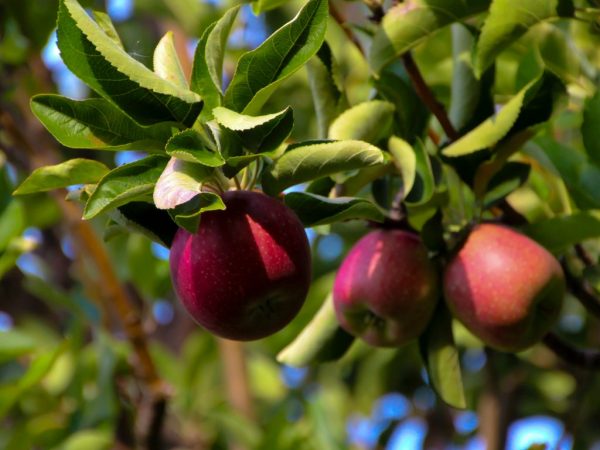
Varietal characteristics of the apple tree Kitayka Kerr
Characteristic
The beauty of the Kitayka Kerr tree is one of the advantages of the variety. The apple tree stands out against the background of other cultures: thanks to the beautiful flowers that resemble sakura, the species received such a name. Flowering period falls in April - May. Immediately after this, the twigs are covered with many small fruits.
Massive inflorescences exude a strong but pleasant aroma. It attracts bees that pollinate the tree. As a result, the quality characteristics of the fruits increase.
The average yield of the species is up to 120 kg of apples from one tree.
The variety is frost-resistant, for which gardeners all over the world love it. The culture takes root well in central Russia and on the territory of Ukraine. The apple tree survives drought and even without additional moisture it gives a stable harvest. Resistance to various garden diseases is average.
Description of fruits
Fruit color is bright dark red. The longer the apples are "infused", the darker the shade of their peel. The weight of one fruit is up to 45 g.
The first fruits are formed in the 4th year. From this point on, the yield will increase. A stable indicator will be achieved in 7-8 years, after the final growth of the lateral lashes.
The description of the fruits during the ripening period suggests that closer to autumn, the late-ripening variety begins to gain sweets, so you cannot rush to harvest.
The taste of apples is moderately sweet, moderately sour. The fruit will develop astringency in the last weeks of ripening. The pulp is firm, but juicy. It contains a large amount of vitamin C, which makes the product very useful for both adults and children.
The pulp is also rich in such a rare vitamin P, which has a beneficial effect on the cardiovascular system. The purpose of the variety is universal. They can be used for juicing, preserves and baked goods. If you freeze a product, it does not lose its quality characteristics.
The appearance of the tree
The tree is characterized by a complex root system - it is partially located on the surface. The roots grow quickly, providing the apple tree with constant nutrition. According to the description, the tree grows up to 10 m in height. The annual growth is at least 70 cm. In the first years after being placed in the ground, the seedling grows rapidly.
The crown of the apple tree is round in shape with medium thickening. Leaves are light green.
Light inflorescences are formed on the tree. The decorative crown needs to be decorated from the first years: the earlier the branches are trimmed, the more beautiful the tree will be.
Landing
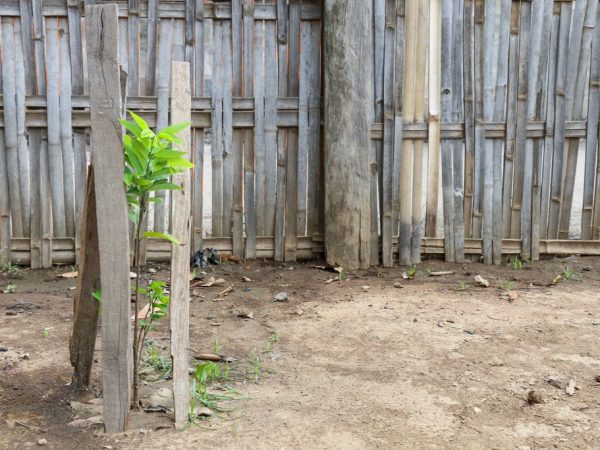
Choose only healthy seedlings for planting
The Kitayka Kerr variety, like any other, is planted according to a simple scheme.The whole process contains several stages. To begin with, a suitable site is prepared, after which the planting material is selected. At the third stage, you need to make a landing pit.
The apple tree will grow quickly, and after a week after planting, it is important to establish full and regular care.
Sapling selection rules:
- pay attention to the root system. If a seedling is bought, it needs to be checked - if the grafting was wrong, the roots will easily come off and break. Properly prepared material will have flexible but strong roots;
- examine the seedling. If there are spots or any signs of a previous illness, the seedling is not placed in open ground. There is a risk that such a specimen will not survive the adaptation period and will dry out. It should be green underneath the main bark;
- it is better to choose biennial crops. They are more persistent and suitable for spring or autumn planting.
The variety belongs to the category of tall trees, therefore, material with a good root system is selected. It is important that there are no fresh leaves on the shoot. The seedling is pre-soaked in a solution that will strengthen its defense mechanisms. Fitosporin is suitable for these purposes.
Seat selection
The grade needs a hill. If the site is in a lowland, the apple tree will need more strength to take root. Groundwater determines where the tree is best planted. If their height is 3 m, the rhizome will be able to adapt. The higher the water, the more difficult it is for systems like the tall Kitayka Kerr tree to grow.
With a groundwater height of 2.5-3 m, drainage needs to be done. He will be able to protect the root system. The danger of close proximity of waters is that they will leach nutrients from it. As a result, the apple tree will grow, but slowly and will often hurt.
To further protect the culture, small channels are created from the selected place. They will be able to drain excess moisture.
The variety is unpretentious to the quality of the soil. If the site has a high clay content, several buckets of river sand are preliminarily introduced. Sandy soils are the most suitable option for a seedling.
The tree is protected from the wind: its root system is not very durable. If there is a shelter nearby, it should not shade the apple tree - the variety is photophilous.
Disembarkation dates
Apple crops are planted in May and October. These are averaged indicators that directly depend on the region. Spring work is carried out not earlier than warming. The soil layer should warm up to 10 cm, and only then can planting holes be created.
Spring work must not be delayed. As soon as buds are formed on other trees, it is impossible to plant an apple tree - it will not have time to bloom and its growing season will not be included in the standards.
In the fall, planting of strong two-year-old seedlings is beneficial. They are vaccinated and will not suffer from low air temperatures at night. You need to wait until the entire autumn harvest is harvested from the garden, and only then dig a hole for planting a new tree. It is better to carry out such work 30 days before frost.
Planting patterns in spring and autumn do not differ dramatically. In the fall, fertilizing is applied to give the tree strength, and immediately prepare it for winter. In the spring, a week after planting, the apple tree needs regular feeding and watering. The stability of the seedlings is the same.
Landing scheme
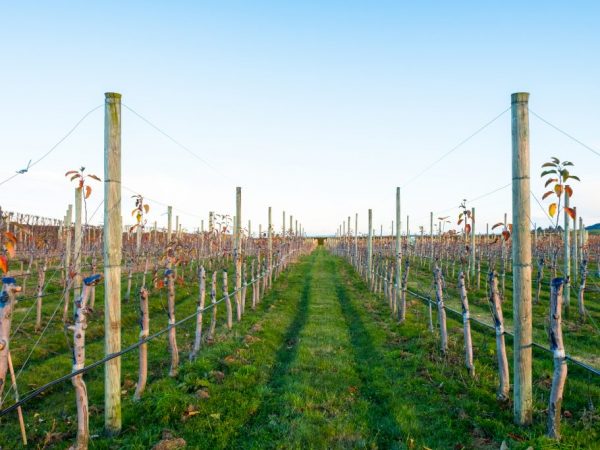
For apple trees, it is better to choose an elevated place
Planting begins by creating the correct planting pit. Its depth is at least 80 cm.The diameter of the pit is 70-100 cm.The variety requires space, therefore, a distance of 4-6 m must be observed to the neighboring culture in the garden.
A special fertilizer is poured into the finished pit. It is better to use organic matter, which will provide additional nutrition for the seedling rhizome. Slurry or compost is added in a thick layer. The pit should stand for 7 days, during which the soil has time to soak.
After a week, the top layer is loosened.If the soil of the site is fertile, instead of organic matter, another mixture is introduced - it consists of one part of deciduous soil, three - humus and one - sand. For another week, the pit should "settle".
Before planting, 2-3 days before the appointed date, you need to apply mineral fertilizer. A good option is one part of potassium sulphide, two of wood ash and 20-30 g of superphosphate.
The seedling is carefully placed in the hole, the roots must be sprinkled on top with soil. The final stage will be watering the seedling. It will take 5-6 buckets of water. A soil roller is formed around the trunk. This will help trap moisture around the tree. After 7-10 days, it will completely complete the rooting process.
Care
The most intensive care is needed in the first years after disembarkation. A young tree needs support: it is installed 10-15 cm from the trunk. The seedling must be tied to it.
The tree should not be allowed to bloom until it reaches a height of 4-5 m. Otherwise, the inflorescences will draw out all the moisture from the rhizome - the fruits will be of poor quality, and the growth of the culture will be inhibited.
The apple tree in all periods of development requires preventive treatment, fertilization and watering - three stages of constant care will ensure its correct growth.
The following procedures are recommended:
- remove weeds - due to the unusual structure of the rhizomes, they cannot be allowed to grow, because they harm the Kitayka Kerr apple tree;
- loosening the soil is a simple technique that will help improve the quality of fertilizing and moistening the soil layer;
- spray the tree in the same period as other apple trees - fungicides are used to strengthen garden crops.
Experienced gardeners advise mulching trees for the winter. This allows you to give the strongest protection for the rhizome, especially its superficial part. They use peat, straw, etc. Protective nets will protect the crop from attack by pests.
Irrigation works
Watering occurs up to 4-5 times per season. There is no need to increase moisture even in summer. You can combine regular watering and irrigation of the leaves. It is important to do the work in the evening. Combine watering with fertilization. The liquid must first be warmed up in the sun.
The variety does not tolerate root watering - you need to moisten the tree, retreating 5-7 cm from its trunk. The younger the seedling, the further the trenches must be, through which moisture enters. Watering the roots can damage them or wash out the topsoil.
In winter, irrigation does not take place: watering is stopped with the arrival of frost and resumed after all the snow has melted and the soil warms up.
Fertilization
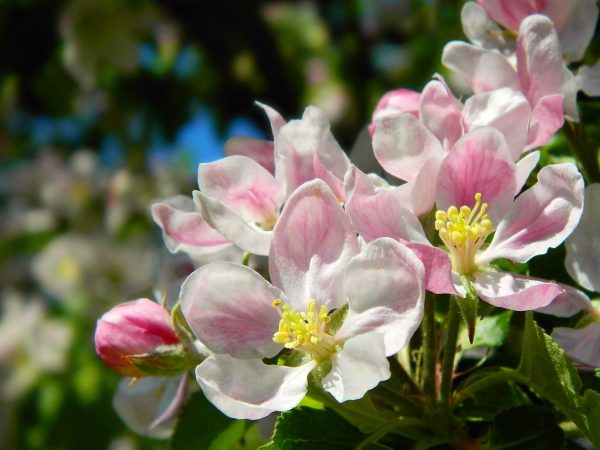
Organic fertilizers will not interfere with the flowering period
In the early years, the variety does not need frequent feeding. From 4-5 years old, when fruiting is established, the tree is fertilized 2-3 times a season. When lateral lashes grow and there is a period of intensive fruit formation, it is better to introduce organic matter: it must be diluted with water so as not to injure the culture.
Organic fertilizers can be combined with nitrogen supplements - such dressings do not harm the apple tree. Ammonium nitrate helps the cultivar to strengthen its unstable root system. For 1 sq. m of the trunk circle, no more than 30 g of fertilizer is applied.
During the flowering period of the tree, it is also recommended to use organic matter.
In the spring, the apple tree is fed with superphosphate. The drug is introduced in the following proportions: per 1 sq. m of the trunk circle 30 g of active substance. At the same time, wood ash is also used - up to 2 tbsp. for 1 sq. m.
Pruning branches
The tree needs a procedure of 2 types of pruning. The first spring allows you to form a crown. The procedure is carried out after the tree has recovered after winter, when there are no ovaries on it yet. If buds appear, pruning is dangerous.
Mandatory pruning is needed in the fall - sanitary. Broken or diseased branches are carefully removed during this period. Places of cuts are treated with disinfectant solutions. It is impossible to carry out a sanitary procedure before harvesting.
Protection against diseases and pests
As soon as the snow begins to melt, the trunk should be carefully examined. If it shows signs of illness, spraying is necessary. It also serves as prevention. The trunk and twigs are treated with garden pitch. If the tree has suffered from pests and the bark has been gnawed, an additional vaccination will save the situation.
Crop protection from pests is carried out using these means:
- "Nitrofena". This is a comprehensive tool. It is suitable for both treatment and prevention. It destroys fungi and any larvae that live in the bark. It is used in the spring to prevent disease after warming;
- solution of copper sulfate. It prevents the vitriol from rotting. The product promotes rapid wound healing, especially after spring pruning;
- urea. Suitable for controlling powdery mildew and scab. For 0.5 kg of a substance, 10 liters of water are needed. One adult tree needs up to 3 liters of fresh solution.
Ripening and fruiting
The variety has a high fruiting rate. From the 4th year, the first full-fledged harvest will already be formed. Fruits grow in clusters on lateral branches. A total of 4-8 apples per bunch. This arrangement of fruits allows you to speed up the harvesting process.
Up to 100 kg of fruit can be removed from one tree. They all ripen at the same time. Pruning the ovaries in the early years helps to increase the rate of fruiting in the future.
Harvesting and storage
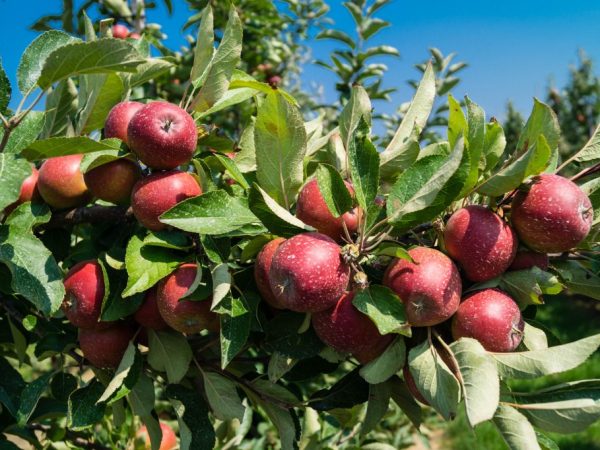
Fruits are harvested once before frost
The optimal time for harvesting is September. The apples are harvested at the same time. You cannot leave them on the branches until frost. If the fruits freeze, they will lose their quality characteristics. Collect apples directly into wooden boxes.
The harvest is stored in special conditions. The room temperature should be no more than 1 ° C. The average storage period for a crop is 2-3 months. It is best not to keep different types of fruits together.
Fruits are distinguished by good transportability: they do not lose their attractive appearance.
Testimonials
Gardeners' reviews are conventionally divided into two categories - about the tree that decorates the land, and about small fruits. A beautiful apple tree can become a highlight of any site. Fruits contain useful trace elements and vitamins, which are useful both in dietary nutrition and in the first complementary foods.
Experienced gardeners say that apples are good to grow for sale - they do not last long, but are suitable for making delicious juices and preparations for the winter. The tree grows quickly and rarely gets sick - these advantages cover all the disadvantages of the variety.

